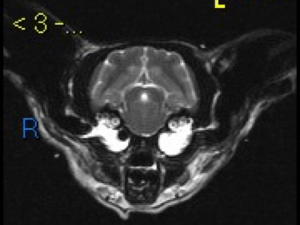Facial Paresis
Back to Fact Sheets
Facial paresis is impaired function of the muscles of facial expression.
Download PDF
What is facial paresis?
Facial paresis is impaired function of the muscles of facial expression. This occurs when the facial nerve, which supplies these muscles, becomes damaged or impaired in some way. The impaired muscle function leads to drooping of the ear, lip and eyelids and reduced blinking. Due to drooping of the lip, food water or saliva may fall from the mouth. Most commonly, one side of the face is affected. When this occurs, in the early stages, the nose can deviate towards the unaffected side due to the unopposed muscle tone on the normal side. Longer term, fibrous tissue can form on the affected side and this can contract, pulling the nose back towards that side. It is less common for both sides of the face to be affected at once. The severity of the clinical signs can vary. An animal with reduced muscle function has facial paresis, whereas one with complete loss of muscle function has facial paralysis.
In addition to supplying the muscles of facial expression, the facial nerve also innervates the lacrimal glands, which produce tears, the mandibular and sublingual salivary glands and the taste buds in part of the tongue. While impairment of taste and salivation are not commonly recognised as a clinical problem in cases of facial paresis, reduced tear production, combined with inability to blink, which would normally spread the tear film over the eye to lubricate it, can be problematic and does need to be managed (see below). Sometimes, instead of blinking, the animal will be able to retract the eyeball, resulting in flicking of the third eyelid across the surface of the eye which acts to some extent as a substitute for blinking.

What causes facial paresis?
Facial paresis can be caused by any disease process that affects the facial nerve. Possibilities include:
- Infection within the middle ear is one of the most common reason: as the facial nerve passes through this area it can get inflamed when there is a middle ear disease
- Idiopathic facial neuropathy is dysfunction of the facial nerve for which no underlying cause can be identified. This is a very common cause of facial nerve dysfunction in dogs
- Central nervous system disease, particularly an inflammatory disease affecting the brain stem where the facial nerve originates from
- Tumours, for example lymphoma and peripheral nerve sheath tumour, can affect any nerve, including the facial nerve but they are uncommon
- Myasthenia gravis, which is a disease-causing dysfunction of the junction between nerves and the muscles they innervate, occasionally causes facial weakness and tiredness.
How do we investigate it?
The presence of these underlying causes may be investigated by performing general and neurological examinations and blood tests but more important diagnostic imaging like an MRI of the head. At the time of the MRI, Cerebrospinal fluid (the fluid that surrounds the brain and spinal cord) sample or even a myringotomy (sample trough the tympanic membrane) might be performed if a meningitis or an ear infection is suspected.

MRI of bilateral middle and internal ear disease in a cat
What treatment is required?
Regardless of the underlying cause, it is important that the eye is kept lubricated and carefully monitored for signs of ulceration for example redness, discharge, swelling or rubbing of the eye. Gentle stimulation of the skin around the eye may encourage your pet to blink and acts as a form of physiotherapy. This can be performed several times a day. This also provides an opportunity to check for any sign of injury to the eye and to monitor for any improvement in function.
Treatment for the underlying disease depends on whether a specific cause that is amenable to treatment can be identified.
Ear infections may be treated either medically (antibiotics for several weeks to months) or surgically. Our multidisciplinary service of dermatology and surgery specialists will work together with the neurology service if this is the problem that your pet presents.
Meningitis is typically treated with steroids and other inmuno-suppresive medication (cytarabine, procarbazine, cyclosporin) for a minimum of 1 year.
Last but not least, idiopathic facial paralysis does NOT require any specific treatment other than keeping the eye lubricated and healthy
What is the prognosis?
The prognosis depends on the underlying cause. Even with optimal diagnosis and treatment, the nerve may be permanently damaged and deficits may persist. This should NOT affect your pet’s quality of life.
In idiopathic facial paresis, spontaneous improvement may occur in a few weeks to months. However, many affected dogs can be left with permanent deficits (around 70%) and relapses are common, on the same or the opposite side.


